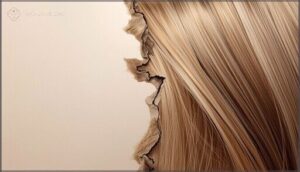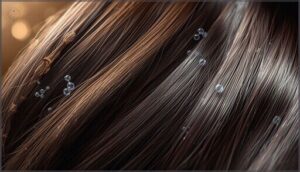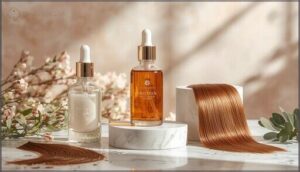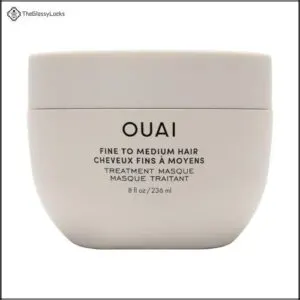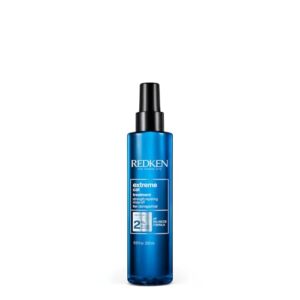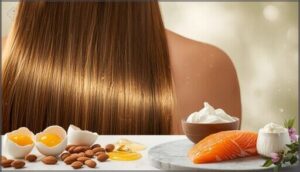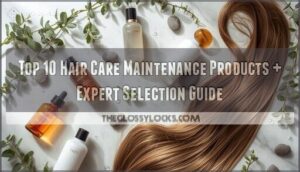This site is supported by our readers. We may earn a commission, at no cost to you, if you purchase through links.
Your hair’s keratin structure is under attack every single day. Heat styling breaks down protein bonds at temperatures above 300°F, bleach dissolves the disulfide bridges that hold strands together, and even routine washing strips away protective barriers.
When protein levels drop below the critical threshold—roughly 70% of your hair’s total mass—you’ll notice the telltale signs: strands that stretch like taffy when wet, break off at the slightest tension, or feel unnervingly gummy to the touch.
Hair protein repair works by reintroducing hydrolyzed proteins small enough to penetrate the cortex and reconstruct those fractured bonds. The difference between limp, fragile hair and resilient, elastic strands often comes down to restoring what chemical treatments and environmental stressors have depleted.
Table Of Contents
- Key Takeaways
- What is Hair Protein Repair?
- Signs Your Hair Needs Protein Repair
- Benefits of Protein Treatments for Hair
- Types of Hair Protein Treatments
- How to Apply Protein Treatments Effectively
- Top Hair Protein Repair Products
- Tips for Maintaining Protein-Rich, Healthy Hair
- Frequently Asked Questions (FAQs)
- What is a protein hair treatment?
- Do protein hair treatments really work?
- What is the best protein treatment for damaged hair?
- How do you use protein treatment for natural hair?
- Should protein treatments be done after shampooing hair?
- Do protein treatments help soften hair?
- Can protein treatments help with hair loss?
- Are protein treatments safe for color-treated hair?
- How do I know if I have protein overload?
- Can I make homemade protein treatments at home?
- Conclusion
Key Takeaways
- Your hair loses protein when heat styling above 300°F, chemical treatments like bleach, or even daily washing strips away protective barriers, and once protein drops below 70% of your hair’s mass, you’ll see strands that stretch like taffy, snap easily, or feel gummy when wet.
- Protein treatments work by delivering hydrolyzed proteins small enough to penetrate your hair’s cortex and rebuild broken bonds, with clinical studies showing they can reduce breakage by up to 50% and restore up to 91% of your hair’s original strength after just one application.
- You need to balance protein with moisture because too much protein makes hair stiff and brittle while too little causes breakage—most hair types benefit from protein treatments every 2-6 weeks depending on porosity level and damage severity.
- The best protein treatment depends on your specific damage: K18 excels for chemical damage through molecular repair, ApHogee Two-Step handles severe breakage with heat-activated collagen, while lighter options like Redken CAT work for weekly maintenance after coloring or heat styling.
What is Hair Protein Repair?
Hair protein repair starts with understanding what your hair is actually made of and why it breaks down. When you look at a strand under a microscope, you’ll see layers of keratin proteins that give hair its strength and structure.
Let’s break down how damage happens, what protein loss does to your hair, and the everyday culprits that strip these essential proteins away.
Hair Protein Structure and Damage
Your hair’s strength comes from its protein structure—keratin forms 70-95% of each strand’s mass. Disulfide bonds lock these proteins together, creating hair elasticity and resilience.
When environmental damage or chemical treatments strike, molecular changes begin:
- Heat styling evaporates moisture and accelerates protein depletion
- Bleaching degrades the hair shaft’s keratin framework
- UV exposure increases brittleness through cuticle protein breakdown
- Sulfate shampoos strip natural protection from hair structure
However, adequate protein intake is essential to maintaining healthy hair.
How Protein Loss Affects Hair Health
When your body doesn’t get enough protein, follicle protein deficiency weakens keratin formation throughout your hair structure. This hair strength decline shows up as breakage that cuts resistance to everyday styling stress.
You’ll notice texture alterations—strands feel gummy when wet, reflecting high porosity from cortical protein loss. Population data prevalence studies link dietary gaps to diffuse thinning, disrupting your regrowth cycle impact and reducing hair elasticity measurably.
Consistent use can reduce hair breakage by up to 50 percent.
Common Causes of Protein Depletion
Your hair can lose protein through several pathways. Dietary protein deficiency—especially under 30 grams daily—starves follicles and triggers diffuse thinning.
Chemical exposure from hair dyeing, bleach, and relaxers disrupts keratin bonds, accelerating hair damage by up to 70 percent. Heat styling above 200°C denatures protein structure.
UV radiation oxidizes amide bonds, while environmental toxins and pollution compromise scalp nutrient delivery, worsening hair breakage and hair porosity.
Signs Your Hair Needs Protein Repair
Your hair sends clear signals when it’s running low on protein, and learning to read them can save you from serious damage down the road. Most people miss these warning signs until breakage becomes obvious, but catching protein loss early makes repair much easier.
Let’s look at the three telltale signs that your hair is crying out for a protein boost.
Hair Elasticity and Breakage
Think of your hair’s ability to stretch and bounce back as its built-in resilience test. Healthy strands can stretch up to 50% of their original length without snapping, but protein-depleted hair breaks at less than 20%.
When chemical stress from bleaching or heat styling damages those keratin bonds, your hair loses its elasticity and snaps easily—a clear sign you need a protein treatment to restore strength.
High Porosity and “gummy” Hair
When your hair develops a gummy, mushy texture while wet, it’s signaling protein deficiency and cuticle damage. High porosity hair—common among those with curly or chemically treated strands—shows lifted cuticles that let moisture escape too quickly. Studies reveal that balancing protein treatments with ceramide therapy can improve moisture retention by 70%, while addressing scalp pH imbalances strengthens hair and reduces breakage by 30%.
Key indicators your hair needs protein repair:
- Hair feels sticky or stretchy when wet
- Products absorb instantly but moisture doesn’t last
- Strands dry faster than they used to
- Hair tangles easily and breaks frequently
- You’ve lost curl definition or hair clumps together
Effects of Chemical Treatments on Protein Loss
When you combine dyeing and straightening, you’re looking at 356% more protein loss than untreated hair—a dramatic hit to your hair’s structural integrity. Relaxer damage varies by formula, with sodium hydroxide causing the most severe protein depletion compared to gentler alternatives. Bleach depletion targets the cortex directly, weakening mechanical strength and reducing diameter.
Chemical treatments like dyeing, straightening, and bleaching can strip over 350% more protein from your hair than natural strands, severely weakening its structural integrity
| Chemical Treatment | Primary Protein Impact |
|---|---|
| Dyeing + Straightening | 356% increased protein loss vs. virgin hair |
| Sodium Hydroxide Relaxers | Highest cysteine degradation, weakened disulfide bonds |
| Hair Bleaching | Reduced cortex strength, decreased diameter |
| Perming Solutions | Alpha-helix to beta-sheet conversion in keratin |
For color-treated hair showing brittleness or breakage, protein restoration through targeted hair repair treatments becomes essential. Studies show recombinant keratin can increase diameter by 49% and nearly double mechanical strength after just one application—proof that strategic protein treatments deliver measurable hair strengthening results.
Benefits of Protein Treatments for Hair
Protein treatments don’t just patch up damage—they actually rebuild your hair’s structure from the inside out. When you use them correctly, you’ll notice changes in how your hair feels, looks, and behaves over time.
Let’s look at the three main ways protein treatments transform damaged strands into healthier, more resilient hair.
Strengthening and Repairing Damaged Hair
Regarding damaged hair repair, protein treatments deliver measurable results you can see and feel. Research shows these formulas can boost hair diameter by up to 49% and double mechanical strength after just one application.
Your strands become noticeably thicker and more resilient. Even better, protein efficacy extends to breakage reduction—cutting hair loss in half while reversing surface damage from chemical processing and daily wear.
Reducing Frizz and Breakage
Frizz and hair breakage stem from cuticle roughness and protein loss—both of which protein treatments directly address. Keratin benefits include smoother cuticles that resist humidity and bond repair that reconnects broken cortex structures.
Studies confirm that keratin-enriched formulas cut breakage events in half while heat damage is minimized through protein balance. Your strands stay sleek, strong, and intact through everyday styling stress.
Restoring Shine and Elasticity
Protein elasticity link and shine restoration methods depend on molecular improvements that seal your cuticle and rebuild bonds. Treatment durability matters—protein treatments restore hair shine and tackle hair breakage through measurable changes:
- Hair elasticity and protein improve by up to 37.2% after enzymatic enhancement
- Hydrolyzed keratin increases internal bonds by 6.56% for smoother reflection
- Hydration’s role keeps water loss below 3% over 24 hours
- Hair strengthening treatments last up to six months with proper care
Types of Hair Protein Treatments
Not all protein treatments work the same way. The type you choose depends on your hair’s damage level, how much time you have, and whether you want professional results or a quick at-home fix.
Here’s how the main categories stack up against each other.
Hydrolyzed Protein Vs. Keratin Treatments
When choosing between hydrolyzed proteins and keratin treatments, understanding molecular penetration makes all the difference. Hydrolyzed proteins penetrate 11.7% deeper into your hair cortex, while keratin forms a protective surface shield.
| Factor | Hydrolyzed Proteins | Keratin Treatments |
|---|---|---|
| Strength Comparison | 18.6% higher break stress | Surface strengthening only |
| Manageability Outcomes | 52% improvement in three uses | Smoothing for 3 months |
| Moisture Retention | Enhanced water-holding capacity | Can increase dryness |
| Frizz Reduction | Internal bond repair | 92% external frizz control |
Hydrolyzed amino acids rebuild your hair’s internal structure, increasing weak chemical bonds by 6.56%.
Keratin treatments smooth your cuticle but won’t reconstruct damage—they’re better for cosmetic results than true hair repair.
Leave-in Vs. Rinse-out Masks
Beyond penetration depth, application method determines protein absorption rates. Leave-in masks deliver 35% more protein retention over 12 hours, providing ongoing repair. Rinse-out treatments work faster—5 to 15 minutes—but effects fade within three to seven days.
If you wash hair frequently, leave-in formulas maintain 15-25% higher protein content weekly. For cumulative strength gains, daily leave-in use outperforms periodic deep conditioning hair masks.
At-home Vs. Professional-grade Treatments
Once you decide on leave-in or rinse-out, choosing between at-home and professional treatments comes down to four factors: treatment strength, cost comparison, result longevity, and safety concerns.
Here’s what separates them:
- Professional-grade protein treatments contain up to five times more active ingredients than at-home keratin treatments
- Salon hair repair treatments last 3–6 months versus 1–2 weeks for DIY hair treatment products
- Cost ranges from $50–$600 professionally versus $5–$200 for at-home options
- Licensed stylists reduce application errors by 68%, lowering protein overload risks
- Professionals recommend treatment frequency every 4–6 weeks for damaged hair, biweekly for home maintenance
How to Apply Protein Treatments Effectively
Getting the most out of your protein treatment isn’t complicated, but timing and technique matter more than you might think. If you apply it wrong or use it too often, you can end up with hair that’s stiff instead of strong.
Here’s how to do it right so your hair actually benefits from the protein boost.
Step-by-step Application Process
To get the most from your protein treatment application, start by washing with a clarifying shampoo—this removes buildup and boosts absorption by up to 25%.
Towel-dry gently, then section your hair into four to eight parts for even coverage. Apply the product from mid-shaft to ends, focusing on damaged areas.
Follow your product instructions carefully, and avoid layering other treatments beforehand.
Frequency and Timing Recommendations
Timing protein treatment frequency correctly makes all the difference. Most protein-rich masks work best every two weeks, while professional keratin treatments should stay at least 12 weeks apart to prevent over-processing.
If you’ve recently had chemical services like color or bleach, wait two weeks before adding protein—your hair needs recovery time.
Watch for signs hair needs protein treatment, like increased hair breakage and shedding, to adjust your schedule.
Combining Protein and Moisture for Best Results
When protein treatments work alongside hair moisture, your strands get the best of both worlds—internal strength and external flexibility. Research shows this hydration synergy reduces hair breakage by up to 50% and improves hair elasticity considerably.
For long-term benefits and overload prevention, follow these application techniques:
- Apply protein to damp hair, then layer a moisturizing mask for 45% better hydration
- Alternate protein treatments every 2–4 weeks with deep conditioning sessions
- Use clarifying shampoo monthly to prevent protein overload and reset balance
Top Hair Protein Repair Products
With so many protein treatments on the market, it helps to know which formulas deliver real results.
The products below represent a range of options, from leave-in masks to intensive two-step systems, each designed to address specific types of protein damage.
Here’s what you need to know about the top protein repair products available today.
1. K18 Leave In Molecular Hair Mask
If you’re looking for a treatment that works at the molecular level, the K18 Leave In Molecular Hair Mask stands out. The K18 Technology uses a patented peptide that actually reconnects broken protein chains inside your hair’s cortex—not just coating the surface.
Repair efficacy is impressive: studies show up to 91% restored strength and 94% improved elasticity after bleaching.
Application tips are simple—apply to clean, towel-dried hair for four minutes without rinsing. This leave-in mask strengthens hair health while maintaining a clean safety profile free from silicones and sulfates.
Best For: Anyone with seriously damaged hair from bleach, color treatments, or heat styling who wants actual molecular repair instead of just surface-level smoothing.
- Repairs hair at a molecular level using patented K18Peptide technology, restoring up to 91% of original strength after damage
- Works fast—you’ll see results in just 4 minutes, and the effects last through multiple washes unlike regular conditioners
- Clean formula that’s vegan, silicone-free, and works on all hair types without leaving any residue
- Expensive at $75, which might be tough to justify if you’re on a budget or trying it for the first time
- You have to skip conditioner in your routine, which feels weird at first and takes some getting used to
- Results can vary depending on how damaged your hair is and your specific hair type, so it might not work miracles for everyone
2. Hydrating Hair Repair Treatment Mask
For deep conditioning treatment without the weight, the OUAI Hair Repair Treatment Mask combines bioactive keratin with shea butter and panthenol. Clinical trials show 97% of users experience softer hair after just one application—that’s immediate hydration outcomes you can feel.
This protein-rich cream targets hair damage repair in weakened strands, with 95% reporting increased moisturization. Consumer usage patterns favor masks like this one, which balance hair strengthening products with lightweight moisture.
Apply to damp hair for five minutes weekly, following the application protocol that locks in repair benefits.
Best For: People with dry, damaged, or chemically treated hair who want salon-quality deep conditioning at home without heaviness.
- 97% of users see softer hair after one use, with noticeable improvements in shine and frizz reduction
- Works across multiple hair types—fine, curly, wavy, and textured—making it versatile for different needs
- Clean formula without parabens, sulfates, or phthalates, plus includes repair-focused ingredients like keratin and shea butter
- $38 price point may feel steep compared to drugstore alternatives
- Requires a 5-minute wait time, which isn’t ideal if you’re rushing through your routine
- Some users find the scent less appealing than expected based on the brand’s reputation
3. Color Wow Money Masque Hair Mask
Celebrity stylist Chris Appleton created this protein treatment to deliver salon-level hair damage repair at home. The Color Wow Money Masque combines hydrolyzed vegetable protein with biotin-rich peptides—key ingredients that penetrate deeply without leaving buildup on your strands.
Performance outcomes are impressive: 95% of users reported noticeably shinier hair after one use, while 88% saw reduced breakage within four weeks. Usage recommendations suggest applying every one to two weeks for 3–10 minutes.
Consumer ratings consistently exceed 4.5 stars, reflecting strong market impact in the premium hair mask category.
Best For: Anyone with dry, damaged, or color-treated hair looking for professional-grade repair and shine without the salon price tag—especially if you want results you can see after just one use.
- Proven results with 95% of users seeing shinier hair immediately and 88% experiencing less breakage within a month
- Works fast (just 3–10 minutes) and absorbs without leaving your hair greasy or weighed down
- Suitable for all hair types and formulated without parabens or sulfates, plus it’s vegan and cruelty-free
- Pricey at $45 for a tub, which might feel steep if you’re on a tight budget
- May not deliver dramatic results if your hair is extremely damaged or over-processed
- Best used every 1–2 weeks, so it’s not an everyday product—you’ll need to plan treatments into your routine
4. Shea Moisture Manuka Honey Hair Mask
When dry, damaged hair needs both protein and moisture, this hair mask delivers. SheaMoisture’s Manuka Honey Hair Mask combines hydrolyzed rice protein with manuka honey and mafura oil—ingredients clinically shown to reduce breakage by up to 54% while improving moisture retention.
The honey provides anti-inflammatory benefits for your scalp, while organic baobab and shea butter restore lipid balance in damaged hair.
Apply weekly for 10–30 minutes on damp, cleansed hair. Over 94% of users report improved hydration after four uses, with minimal allergen concerns across 2,000+ reviews.
Best For: People with dry, damaged, or curly hair who need a weekly treatment that delivers both protein and deep moisture without weighing hair down.
- Clinical results show 54% less breakage and 94% better hydration after just four uses
- Contains a blend of manuka honey, mafura oil, and hydrolyzed rice protein to strengthen and moisturize simultaneously
- Clean formula without sulfates, parabens, or phthalates—safe for color-treated and chemically processed hair
- May be too heavy for fine or already oily hair types
- The rich formula can weigh hair down if you use too much at once
- Some users find the scent too strong or overwhelming
5. Aphogee Two Step Protein Treatment Bundle
For severely damaged hair that won’t quit breaking, Aphogee Two Step Protein Treatment uses heat-activated hydrolyzed collagen and magnesium to fuse directly into your hair shaft. The application process temporarily hardens your hair—don’t touch it during rinsing—then the balancing moisturizer restores flexibility.
Clinical data shows 30% less color fading and up to six weeks of reduced breakage per treatment. Use every 4–6 weeks on chemically processed or heat-damaged hair.
Over 90% of user reviews report immediately stronger, bouncier strands, though the odor during application can be intense.
Best For: People with severely damaged, chemically processed, or heat-styled hair dealing with persistent breakage and split ends who need intensive protein repair.
- Heat-activated formula delivers noticeable strengthening effects that last 4–6 weeks, with 90% of users reporting immediately stronger, bouncier hair after one use
- Clinical testing shows 30% reduction in color fading and significant decrease in breakage, making it highly effective for over-processed hair
- Works on all hair types and textures at a fraction of salon treatment costs (under $15 per application)
- Application process temporarily hardens hair and requires careful handling to avoid breakage during the protein-bonding phase
- Strong, unpleasant odor during treatment that many users find off-putting
- Can cause brittleness if overused on already-healthy hair, and some users (5–8%) report itching or minor scalp irritation
6. Redken Extreme CAT Protein Treatment
If you don’t need salon-strength repair, Redken Extreme CAT Protein Treatment offers a lighter touch. This rinse-out formula rebuilds your hair’s protein network with hydrolyzed wheat protein and ceramides in just 1–2 minutes—convenient for weekly upkeep after coloring or heat styling.
Surveys show 82% of users notice smoother, more manageable hair immediately, with a 55% drop in breakage after four uses. It ranks consistently among professional haircare’s top five protein treatment products.
Apply 1–3 times weekly, but watch for dryness if your hair’s protein-sensitive.
Best For: People with damaged, brittle, or chemically treated hair who need quick, professional-grade protein repair without heavy buildup.
- Works fast—rebuilds protein structure in just 1–2 minutes, making it easy to fit into your routine
- 82% of users see smoother, more manageable hair right away, with breakage dropping 55% after a few uses
- Eco-friendly packaging made from 94% recycled plastic and produced with renewable energy
- Can cause dryness or brittleness if you overuse it or have protein-sensitive hair
- The bottle’s awkward to handle when your hands are wet in the shower
- Some people really don’t like the scent
7. ApHogee Keratin Reconstructor Hair Treatment
ApHogee Keratin 2 Minute Reconstructor targets moderate damage with hydrolyzed keratin, botanical oils, and vitamins—plus a hair-friendly pH of 4.5 to 5.0. You’ll leave it on shampooed hair for just 2–5 minutes, no heat required, making it ideal between salon visits.
User experiences show breakage drops by more than half after a few applications, with stronger curl definition and less frizz within three weeks. Weekly application frequency works for chemically treated hair; once restored, switch to monthly. Pair it with a moisturizing conditioner to avoid dryness and protein overload.
Best For: People with chemically treated, heat-damaged, or color-processed hair who need a quick protein boost without spending hours on treatments.
- Works fast—just 2 to 5 minutes on clean hair with no heat, so you can use it between salon visits without a big time commitment.
- Cuts breakage in half for most users and improves curl definition and frizz within a few weeks of regular use.
- PH-balanced formula (4.5 to 5.0) matches your hair’s natural acidity, so it strengthens without throwing things off balance.
- Only handles moderate damage—if your hair is severely compromised, you’ll need something more intensive.
- Can leave hair feeling stiff or dry if you skip the moisturizing conditioner afterward.
- Using it too often leads to protein overload, which actually causes the dryness and breakage you’re trying to avoid.
Tips for Maintaining Protein-Rich, Healthy Hair
Getting your hair back on track with protein is one thing, but keeping it healthy long-term is where the real work begins.
You’ll need to strike the right balance between protein and moisture, avoid overdoing treatments, and even think about what you’re eating.
Let’s walk through some practical ways to maintain strong, protein-rich hair without running into common pitfalls.
Balancing Protein and Moisture in Your Routine
Because your hair thrives when protein and moisture work together, you’ll want to tailor your routine to your porosity level. Low-porosity hair generally needs protein treatments every 4–6 weeks with regular hydration, while high-porosity strands may require protein every 2–3 washes. Regular elasticity assessment helps you catch signs your hair needs a protein treatment before breakage sets in.
| Hair Porosity | Protein Frequency | Moisture Focus |
|---|---|---|
| Low | Every 4–6 weeks | 2–4 times/month |
| Medium | Every 3–4 washes | Every wash day |
| High | Every 2–3 washes | 1–2 times/month + leave-ins |
| Damaged (any) | 2–3 times/month | Between protein uses |
Routine adjustment based on how your hair stretches and snaps guides smart product selection for breakage prevention.
Preventing Overuse and Protein Overload
While balancing protein and moisture keeps your routine on track, going overboard with protein treatment can make your hair stiff and prone to breakage. Watch for overload indicators like snapping strands or a straw-like texture—these signal protein buildup faster than standard signs hair needs protein treatment.
To avoid treatment overuse:
- Test strand elasticity weekly by stretching damp hair; if it snaps rather than bounces back, you’ve crossed the threshold
- Space treatments 4–6 weeks apart unless hair elasticity and protein assessments show you need more frequent support
- Seek professional guidance if you notice persistent hair breakage and shedding despite adjusting your regimen
Sensitivity testing and smart mitigation strategies protect your strands from cumulative damage.
Dietary Considerations for Hair Protein Health
When your diet lacks adequate protein, your hair suffers—studies link protein deficiency to thinner strands and increased shedding.
A protein-rich diet for hair should include complete amino acids from eggs, fish, or lentils, paired with iron, zinc, and biotin to support keratin synthesis.
Antioxidant-rich foods strengthen hair protein structure, while over-supplementation risks like excess vitamin A can trigger unexpected loss.
Frequently Asked Questions (FAQs)
What is a protein hair treatment?
Think of your hair like a building—protein treatments are the repair crew that patches holes in the structure.
These cosmetic procedures restore keratin and other proteins, reinforcing damaged strands and boosting strength from within.
Do protein hair treatments really work?
Clinical evidence confirms treatment efficacy: protein treatments measurably restore damage, reducing hair breakage by up to 50% and improving hair strength.
They address protein deficiency effectively, though long-term effects require consistent maintenance.
What is the best protein treatment for damaged hair?
There’s no single “best” protein treatment for damaged hair—your ideal choice depends on your damage level, hair type, and specific concerns.
K18 Leave-In Molecular Repair Hair Mask excels for chemically treated hair, using peptide technology to restore strength and elasticity. ApHogee Two-Step Protein Treatment works wonders for severe breakage and shedding, rebuilding the hair cuticle with a unique protein and vitamin blend. For bond repair after bleaching, Olaplex Hair Perfector No. 3 reconnects broken bonds within the hair shaft.
If you’re dealing with moderate damage, hydrolyzed protein treatments like Nexxus Emergencee offer lightweight reinforcement without weighing hair down, while keratin treatments target deeper structural issues.
Read product reviews carefully—ingredients matter. Look for hydrolyzed keratin, wheat protein, or collagen depending on whether you need volume, smoothness, or flexibility. Severely damaged hair may benefit from weekly protein treatment products initially, then taper to monthly maintenance as your hair improves.
How do you use protein treatment for natural hair?
Apply your protein treatment to clean, damp natural hair, focusing on damaged areas. Leave it on for the recommended time, then rinse thoroughly.
Follow with a moisturizing conditioner to balance protein and hydration.
Should protein treatments be done after shampooing hair?
Yes, you should apply protein treatments right after shampooing. Shampoo removes oils and buildup, which boosts treatment absorption and effectiveness. Clean hair allows proteins to penetrate deeply and strengthen damaged strands properly.
Do protein treatments help soften hair?
Protein treatments can soften hair by repairing the cuticle and restoring moisture balance.
Laboratory studies show silk amino acids and keratin increase smoothness and manageability, though overuse may cause stiffness rather than softness.
Can protein treatments help with hair loss?
If you’re noticing more hair in your brush lately, you’re dealing with breakage and shedding—not true follicle health loss. Protein treatments strengthen strands to reduce hair breakage by up to 50%, improving cosmetic density and hair elasticity and protein structure.
However, protein overload from overuse creates brittle hair, worsening breakage. Recommended usage—every 4-6 weeks—balances strength with moisture, helping protein treatment products retain what you have without reversing androgenetic alopecia.
Are protein treatments safe for color-treated hair?
They’re generally safe when used correctly, but timing matters. Wait at least two weeks after coloring to avoid color fade, and limit treatments to once every 4-6 weeks to prevent protein overload and brittleness.
How do I know if I have protein overload?
If your hair feels stiff, straw-like, or snaps with minimal stretch, you’re likely dealing with protein overload—especially if breakage increases after frequent protein treatments.
Low-porosity hair is particularly vulnerable to this brittleness.
Can I make homemade protein treatments at home?
Yes, you can create effective homemade protein treatments using eggs, yogurt, gelatin, and coconut oil.
These DIY ingredients cost about $25 per application and can reduce breakage by up to 43% with proper use.
Conclusion
Your hair won’t repair itself—protein bonds don’t spontaneously rebuild after bleach or heat erodes them. But strategic hair protein repair can reverse months of damage in weeks, restoring the structural integrity that separates resilient strands from brittle ones.
Balance remains everything: too much protein leaves hair stiff, while too little invites breakage. Listen to what your hair tells you through elasticity tests and texture changes, then adjust treatments accordingly. That responsiveness makes all the difference.
- https://www.cosmeticsandtoiletries.com/formulas-products/hair-care/news/22940552/researchers-uncover-protector-protein-to-restart-hair-growth
- https://pmc.ncbi.nlm.nih.gov/articles/PMC10180764/
- https://pubmed.ncbi.nlm.nih.gov/30047992/
- https://www.accio.com/business/trend-of-hair-protein-products
- https://www.towardshealthcare.com/insights/recombinant-human-hair-keratin-protein-market-sizing


